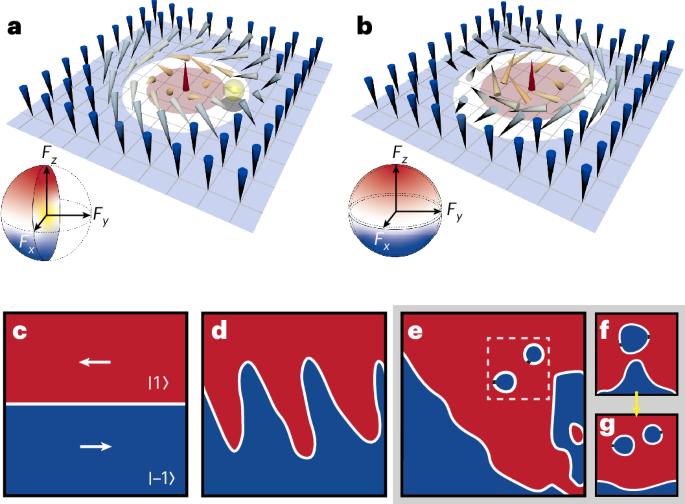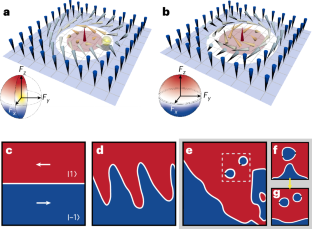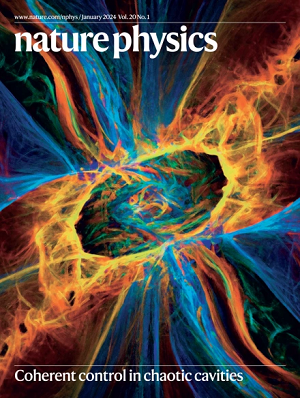来自量子开尔文-亥姆霍兹不稳定性的稳定奇异分数斯基米子自旋织构
IF 18.4
1区 物理与天体物理
Q1 PHYSICS, MULTIDISCIPLINARY
引用次数: 0
摘要
拓扑缺陷会产生非平凡的激励,如孤子、漩涡和天幕,以整数拓扑电荷为特征。然而,当序参数域中存在奇异点时,它们的分类变得困难,使这些电荷的计算复杂化。虽然在超流体3He-A相和自旋玻色-爱因斯坦凝聚体中理论上提出了奇异的非线性激发,但它们没有被实验观察到,也没有研究它们的稳定性。在这里,我们证明了在铁磁超流体中超越拓扑框架的奇异斯基子的存在。这些天子产生于与偏心自旋奇点相关的反常对称性破缺,并携带一半的基本电荷——这是将它们与传统天子和介子区分开来的特征。我们实现了量子开尔文-亥姆霍兹不稳定性的普遍机制,并确定了由磁畴壁发射和具有自旋奇点的整数斯基米子自发分裂产生的非常规分数斯基米子。即使在保持时间为2秒后,奇异天幕仍是稳定的。我们的结果证实了经典和量子开尔文-亥姆霍兹不稳定性之间的普遍性,并拓宽了我们对拓扑量子系统中非平凡织构的复杂非线性动力学的理解。本文章由计算机程序翻译,如有差异,请以英文原文为准。


Stable singular fractional skyrmion spin texture from the quantum Kelvin–Helmholtz instability
Topological defects give rise to non-trivial excitations—such as solitons, vortices and skyrmions—characterized by integer-valued topological charges. However, their classification becomes difficult when singularities are present in the order parameter field, complicating the computation of these charges. Although exotic nonlinear excitations have been theoretically proposed in the superfluid 3He-A phase and spinor Bose–Einstein condensates, they have not been experimentally observed and their stability has not been investigated. Here we demonstrate the presence of a singular skyrmion that goes beyond the framework of topology in a ferromagnetic superfluid. These skyrmions emerge from anomalous symmetry-breaking associated with an eccentric spin singularity and carry half the elementary charge—a feature that distinguishes them from conventional skyrmions and merons. We realize the universal regime of the quantum Kelvin–Helmholtz instability, and we identify the unconventional fractional skyrmions produced by emission from a magnetic domain wall and the spontaneous splitting of an integer skyrmion with spin singularities. The singular skyrmions are stable even after 2 s of hold time. Our results confirm the universality between classical and quantum Kelvin–Helmholtz instabilities and broaden our understanding of complex nonlinear dynamics for a non-trivial texture in topological quantum systems. The quantum Kelvin–Helmholtz instability can induce non-trivial topological excitations. Now a proof-of-principle experiment demonstrates the emergence of a stable singular fractional skyrmion spin texture originating from this quantum instability.
求助全文
通过发布文献求助,成功后即可免费获取论文全文。
去求助
来源期刊

Nature Physics
物理-物理:综合
CiteScore
30.40
自引率
2.00%
发文量
349
审稿时长
4-8 weeks
期刊介绍:
Nature Physics is dedicated to publishing top-tier original research in physics with a fair and rigorous review process. It provides high visibility and access to a broad readership, maintaining high standards in copy editing and production, ensuring rapid publication, and maintaining independence from academic societies and other vested interests.
The journal presents two main research paper formats: Letters and Articles. Alongside primary research, Nature Physics serves as a central source for valuable information within the physics community through Review Articles, News & Views, Research Highlights covering crucial developments across the physics literature, Commentaries, Book Reviews, and Correspondence.
 求助内容:
求助内容: 应助结果提醒方式:
应助结果提醒方式:


